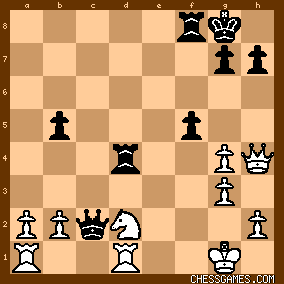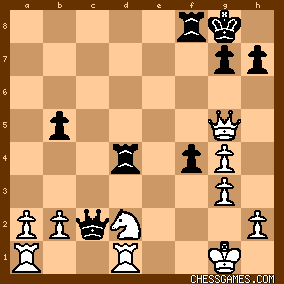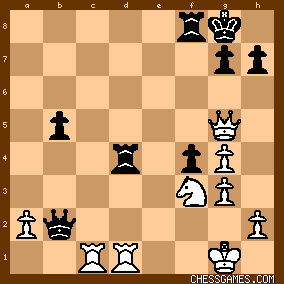|
< Earlier Kibitzing · PAGE 1 OF 2 ·
Later Kibitzing> |
| Dec-07-07 | | yogi1986: Black "Jak" Down
"A beautifully played, scrupulously authentic but strangely evasive exercise in combat ultra-realism." Featured Critic: Johnathan Foreman. New York Post |
|
| Dec-08-07 | | Whack8888: I looked at this opening, and in the chessgames.com database I found it interesting that this is only the third time someone has played 17. Qxd5 --instead 17. Be3 is the most common with 1 White win and 7 draws. 21...Be6 was played in Wang Hao vs D Jakovenko, 2007, but apparantly 22. Qxa6 is playable. Maybe the defensive idea is 22. Qxa6 Bd5 23. Qxb5 Qh3 24. Qf1 |
|
| Dec-12-07 | | crwynn: more like 22.Qa6 Bd5 23.Qb5 Qh3 24.Qd5, 1-0. 24...Bg3 is nothing because of 25.Qg2. |
|
| Sep-10-10 | | sightlesswisdom: Any reason why 29. Rad1 wouldn't work as well? |
|
| Sep-10-10 | | dzechiel: White to move (29?). White is up two pawns. "Difficult." Black has managed to get his bishop trapped behind enemy lines and it is now a desperado. But, at the same time, the white knight is also under attack. The knight cannot move (it would allow 29...Qg2#), so it's time to defend the knight. But how? White has three candidates: - 29 Rad1
- 29 Red1
- 29 Re2
I think we can eliminate the last of these, 29 Re2, as it "unlinks" the rooks and is only asking for trouble. 29 Rad1 is possible, but that leaves both the a- and the b-pawns undefended, and black may be able to get compensation for his piece. I expect the line will go something like
29 Red1 Qxb2 30 Qxh3 Rxd4
and black finds himself down a full piece. There must be more to this position that I'm not seeing. Time to check. |
|
Sep-10-10
 | | al wazir: I had the right idea. The black ♗ isn't going anywhere, so white has to defend his ♘. For once I moved the right ♖, 29. Red1. But the continuation is very tricky, and I certainly didn't see 14 moves deep into it. For example, what happens after 33...Qa4 ? If 34. Qe2/Qf2/Qg2, then 34...Qxa2, and the ♘ is *still* pinned. |
|
| Sep-10-10 | | patzer2: For today's Friday puzzle, 29. Re1! traps the Black Bishop and wins a piece.
However, 29. Ra1 isn't as strong, since 29...Rfe8! avoids the loss of the piece and keeps Black in the game with only a slight advantage for White. |
|
Sep-10-10
 | | scormus: I dunno. Best I can find is 29. Red1. I dont see how B avoids losing the B. Better look it up now |
|
Sep-10-10
 | | scormus: OK, next few moves were as expected, with B getting pressure on the d-file, but not enough to compensate for the piece. I dont ever feel satified with these positions, not positive enough for me to be sure I've got right on top. |
|
Sep-10-10
 | | An Englishman: Good Evening: I saw 29.Red1 and wondered, "Why is this a problem?" Is there some perilous trap that Black didn't play after losing the Bishop that White had to evaluate before winning the piece? |
|
Sep-10-10
 | | Jimfromprovidence: I thought black had good equalizing chances after 29 Rd1 Bg4 30 fxg4 Rxd4.

click for larger viewAfter giving up the bishop, black now double-attacks the knight and the g4 pawn is pinned. After 31 Qg5 f4!? I thought black looked good again as the double-attack on the knight is back on.

click for larger view
This as far as I got, then I had to hit the Rybka freeware.
It finds a counterattack for white and a safe square for the knight after 32 Rac1 Qxb2 33 Nf3. 
click for larger viewWhite keeps his advantage. It got too tough for me at the end. |
|
| Sep-10-10 | | Once: The tao of chessgames.com.
The scene - inside an ancient Shaolin temple, lit only by an unfeasibly large number of candles. Who lights them all? And doesn't the health and safety guy get worried about the fire hazard? Incense burns to fill the air with fragrance. A young boy is being trained by a venerable shaven-headed monk in orange robes. They are both staring at the screen of a laptop computer. "Master, I do not understand," says the student, perplexed. "What do you not understand?"
"This chess puzzle ... it has no smiting blows. Did not master Wu say that all combinations must involve a sacrifice?" The old monk nods gently. "Master Wu says a great many things. Look again at the position. What do you see?" The boy peers at the screen. "I see ... I see that the white knight is threatened and the black bishop too. If the knight moves, then black mates with Qg2# in the Praying Mantis style." "Good, good. Go on. What else do you see?"
"That ... white is two pawns ahead but black is threatening to gobble two pawns back. I do not see a queen sacrifice or a way to give away the knight or threaten mate." The monk points with a gnarled finger at the screen - the same finger that could perform the lethal wushu finger move. "Look there. What does that say?" "Master, it says 'Shirov-Jakovenko 29.' What does it mean?" The monk stands up slowly. "It means, my young apprentice, that this is not a puzzle. It is a real game, played between two flesh and blood opponents. So the answer will not always be the crane kick, if done properly there is no defence. Sometimes the answer will be a simple little defending move. And that is the path of chessgames.com, its essence, its Tao." "I think I understand."
"Today's answer is the simple defending move 29. Red1, and white can steal two pawns but he cannot save his bishop on h3. You youngsters are always looking for the flashy move, the way of the tiger, the dragon style of kungfu. Sometimes, the quiet way is better ... the way of the mouse." "Yes, master." The young student bows deeply.
"Enough instruction for today. Now go back to painting my fence - brush on, brush off..." |
|
Sep-10-10
 | | An Englishman: Good Evening: I think <Jimfromprovidence> found the tactical trickery that I couldn't find. Well done, sir. |
|
| Sep-10-10 | | SamAtoms1980: *SMACKHEAD*
*SMACKHEAD* *SMACKHEAD* *SMACKHEAD* I played 29.Nb3 *SMACKHEAD* *SMACKHEAD* *SMACKHEAD* *SMACKHEAD* . . . . . . . . . .
< < < < < < * * * SMACK - HEAD!!!!!!!!!! * * * > > > > > > |
|
| Sep-10-10 | | vanilla icecream: does 29. Re2 also work? |
|
| Sep-10-10 | | kookoon: Only thought about Rad1 which is a horrible blunder that gives black many mate threats and didn't care about the other rook. |
|
| Sep-10-10 | | Patriot: There's the dual-hanging piece theme again, which means it is possible to ignore it and look for a strong move (29.Re7?) but there doesn't seem to be anything really forcing. But when you look at the state of the bishop on h3, it appears to be trapped! So now attention turns to saving the knight. If you can do that safely you can win the bishop. There are only 3 reasonable candidates (Re2,Red1,Rad1). Moving the knight is unsafe since that allows ...Qg2#. What bothered me about 29.Rad1 is that 29...Qxb2 30.Qxh3 Qxd4+ 31.Kh1 Qf2 and now after 32.Qg2 (32.Qf1) Rxd2. Then I looked at 29.Re2 Qxb2 30.Rae1 Qxd4+ 31.Kh1 and there's no ...Qf2 problem. But in hindsight, black has another option: 29.Re2 Qxb2 30.Rae1 Rxd4. I never took a serious look at 29.Red1, because I figured 29.Rad1 was better since it brought the a1-rook to a more active square. But when you are trying to win a piece, making a rook more active is hardly something to be concerned about. Needless to say, I knew that the solution involved saving the knight but my analysis after that was very flimsy. |
|
| Sep-10-10 | | echever7: I think white can capture that bishop after 29.Re2
Other variants don't seem to work:
29.Rad1-f4 30.Qxh3-Rxd4 and the knight is lost.
The variant I saw after 29.Re2 is 29...f4 30.Qxh3-Rxd4 31.Qe6+ and knight moves after that. |
|
| Sep-10-10 | | echever7: wait a minute there's a little nuance:
29.Red1-f4 30.Qxh3-Rxd4 31.Rac1- and white win a figure after all...So resuming: both 29.Re2 and 29.Red1 win a piece. Better Re2 defending the second row, and the queen side pawns after the variant I showed in the previous commment. |
|
| Sep-10-10 | | Patriot: <echever7> What happens after 29.Re2 Qxb2? I figured 30.Rae1 Rxd4 and it seems difficult for white to hold on to his extra piece. |
|
| Sep-10-10 | | gofer: Now this is a nasty little position. White is 2 pawns up but has allowed the black queen to get a foothold on the 2nd rank
and she is going to be difficult to shift! If white moves the knight we get Qg2#, so only have two options, surrender the knight
for the bishop or try and protect it...
Option 1
29 Qxh3 Qxd2 (Qxb2 Nb3 winning)
30 Rad1 Qxb2 (Red1 Qe3+ causes problems for white)
31 Qg2 ...
and white has weathered the storm and has still one pawn to show for it and its a passed pawn! Option 2
29 Red1 Qxb2
30 Qxh3 Rxd4
31 Nb3 Rxd1+
32 Rxd1 Qxa2
and black has some compensation for the bishop. I have to confess that this is too tricky for me.
Nothing is clear to me. Option 1 seems okay for white, but option 2 isn't too horrendous either!
Time to check... |
|
| Sep-10-10 | | Nut: <Once> .... you slay me. Carry on, sir (or madam, I suppose). |
|
| Sep-10-10 | | kevin86: White protects his piece,then captures black's... |
|
| Sep-10-10 | | patzer2: Correction: For today's Friday puzzle, 29. Red1! traps the Black Bishop and wins a piece. However, 29. Rae1?! is a mistake since 29...Rfe8! avoids the loss of the piece and keeps Black in the game with only a slight advantage for White. P.S.: Per an inadvertent overnight run of Fritz 10, White has only a slight advantage after 29. Rad1 Rfe8 30. Qxh3 Rxe1+ 31. Rxe1 Qxd2 32. Rf1 Qxd4+ 33. Rf2 Rf8 34. Qf1 Qd5 35. a3 f4 36. Qe1 Qf5 37. Qe4 fxg3 38. hxg3 Qg5  (+0.46/@22 depth). (+0.46/@22 depth). |
|
| Sep-10-10 | | Ferro: D'Artagnan |
|
 |
|
< Earlier Kibitzing · PAGE 1 OF 2 ·
Later Kibitzing> |





